MERCEDES-BENZ A-CLASS HATCHBACK 2015 Owners Manual
Manufacturer: MERCEDES-BENZ, Model Year: 2015, Model line: A-CLASS HATCHBACK, Model: MERCEDES-BENZ A-CLASS HATCHBACK 2015Pages: 417, PDF Size: 11.91 MB
Page 371 of 417
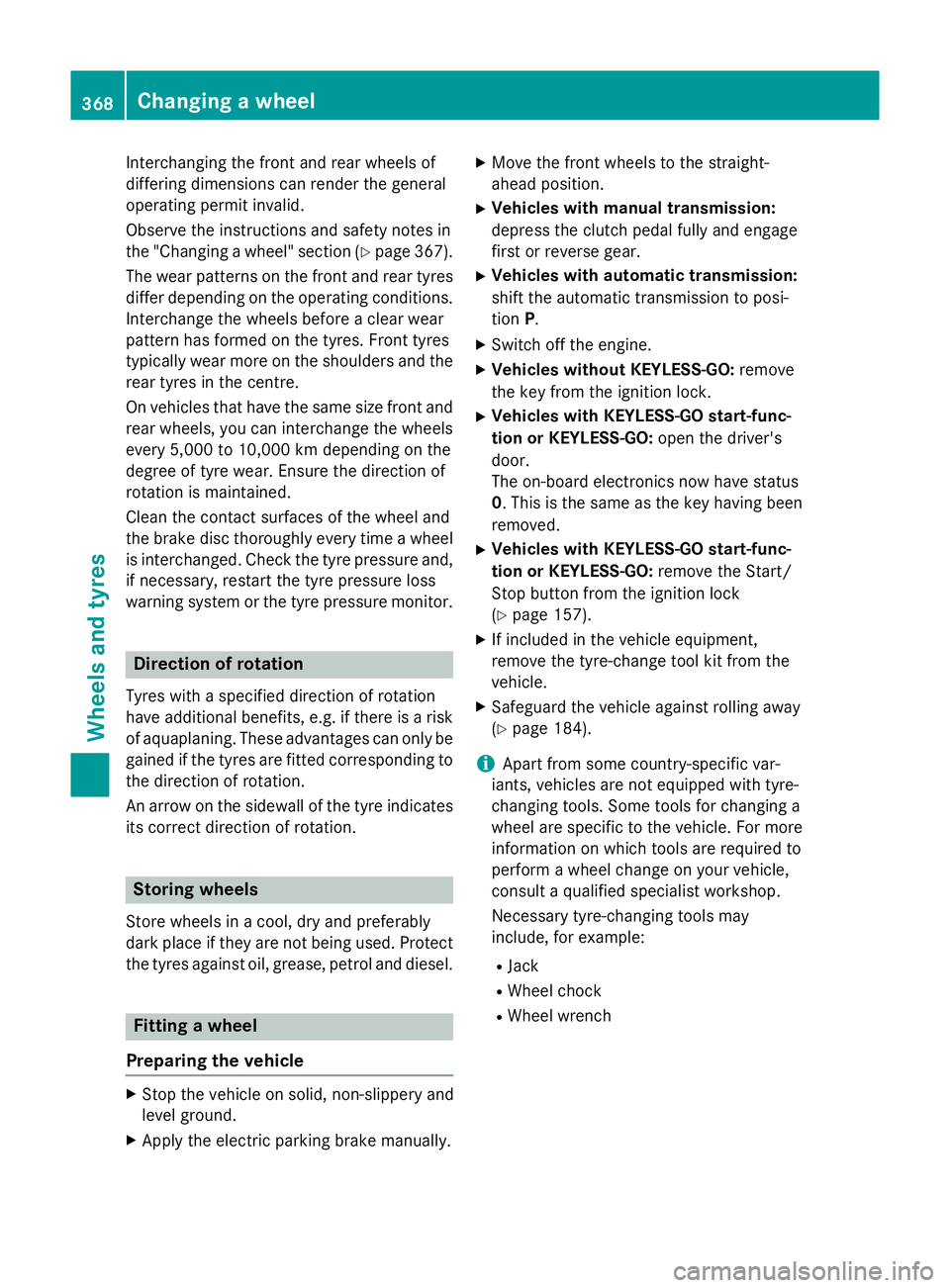
Interchanging the front and rear wheels of
differing dimensions can render the general
operating permit invalid.
Observe the instructions and safety notes in
the "Changing a wheel" section (Y page 367).
The wear patterns on the front and rear tyres differ depending on the operating conditions.
Interchange the wheels before a clear wear
pattern has formed on the tyres. Front tyres
typically wear more on the shoulders and the
rear tyres in the centre.
On vehicles that have the same size front and rear wheels, you can interchange the wheels
every 5,000 to 10,000 km depending on the
degree of tyre wear. Ensure the direction of
rotation is maintained.
Clean the contact surfaces of the wheel and
the brake disc thoroughly every time a wheel
is interchanged. Check the tyre pressure and, if necessary, restart the tyre pressure loss
warning system or the tyre pressure monitor. Direction of rotation
Tyres with a specified direction of rotation
have additional benefits, e.g. if there is a risk
of aquaplaning. These advantages can only be gained if the tyres are fitted corresponding to the direction of rotation.
An arrow on the sidewall of the tyre indicates
its correct direction of rotation. Storing wheels
Store wheels in a cool, dry and preferably
dark place if they are not being used. Protect
the tyres against oil, grease, petrol and diesel. Fitting a wheel
Preparing the vehicle X
Stop the vehicle on solid, non-slippery and
level ground.
X Apply the electric parking brake manually. X
Move the front wheels to the straight-
ahead position.
X Vehicles with manual transmission:
depress the clutch pedal fully and engage
first or reverse gear.
X Vehicles with automatic transmission:
shift the automatic transmission to posi-
tion P.
X Switch off the engine.
X Vehicles without KEYLESS-GO: remove
the key from the ignition lock.
X Vehicles with KEYLESS-GO start-func-
tion or KEYLESS-GO: open the driver's
door.
The on-board electronics now have status
0. This is the same as the key having been removed.
X Vehicles with KEYLESS-GO start-func-
tion or KEYLESS-GO: remove the Start/
Stop button from the ignition lock
(Y page 157).
X If included in the vehicle equipment,
remove the tyre-change tool kit from the
vehicle.
X Safeguard the vehicle against rolling away
(Y page 184).
i Apart from some country-specific var-
iants, vehicles are not equipped with tyre-
changing tools. Some tools for changing a
wheel are specific to the vehicle. For more information on which tools are required to
perform a wheel change on your vehicle,
consult a qualified specialist workshop.
Necessary tyre-changing tools may
include, for example:
R Jack
R Wheel chock
R Wheel wrench 368
Changing a wheelWheels and tyres
Page 372 of 417
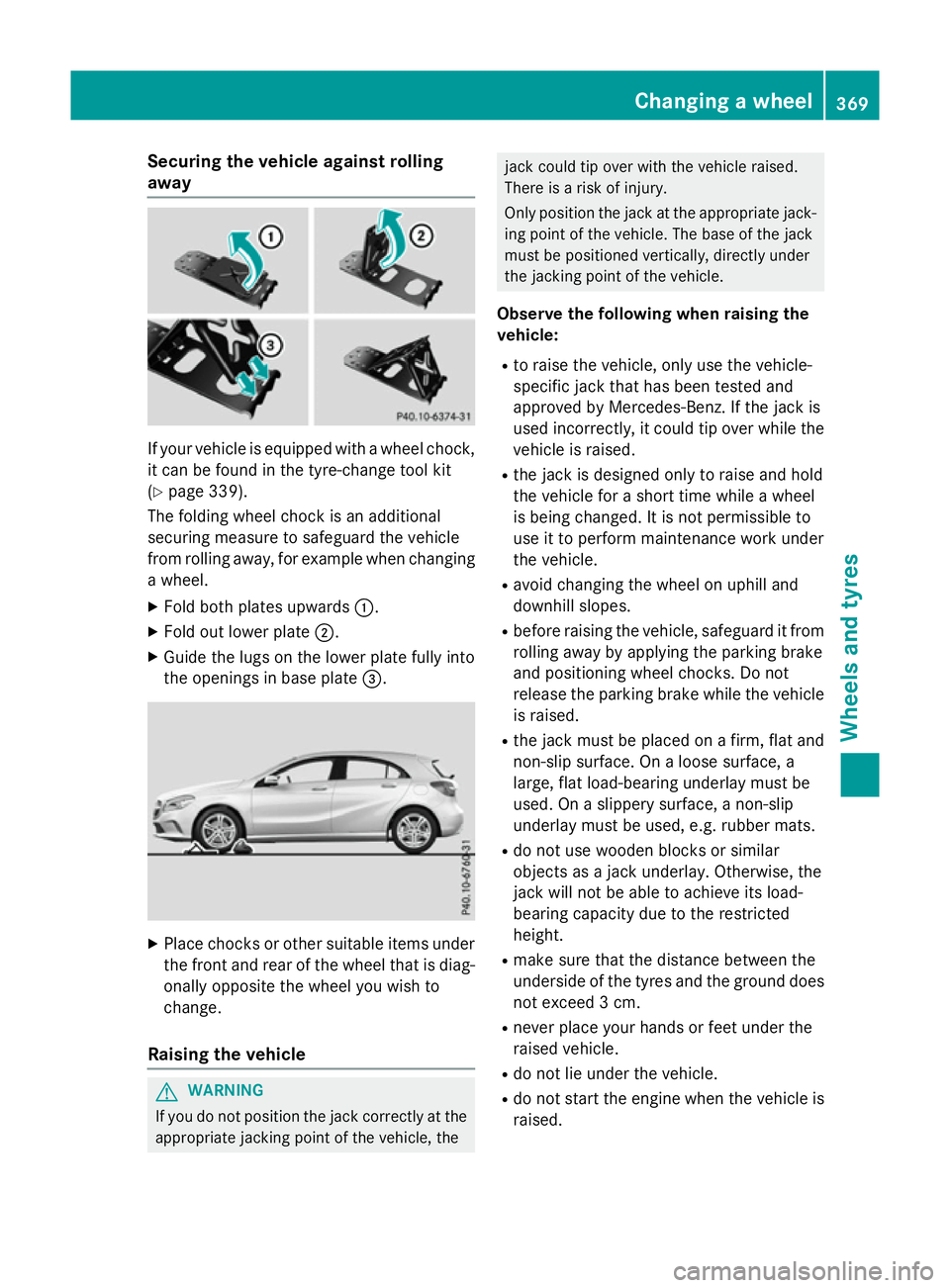
Securing the vehicle against rolling
away
If your vehicle is equipped with a wheel chock,
it can be found in the tyre-change tool kit
(Y page 339).
The folding wheel chock is an additional
securing measure to safeguard the vehicle
from rolling away, for example when changing
a wheel.
X Fold both plates upwards :.
X Fold out lower plate ;.
X Guide the lugs on the lower plate fully into
the openings in base plate =.X
Place chocks or other suitable items under
the front and rear of the wheel that is diag-
onally opposite the wheel you wish to
change.
Raising the vehicle G
WARNING
If you do not position the jack correctly at the appropriate jacking point of the vehicle, the jack could tip over with the vehicle raised.
There is a risk of injury.
Only position the jack at the appropriate jack-
ing point of the vehicle. The base of the jack
must be positioned vertically, directly under
the jacking point of the vehicle.
Observe the following when raising the
vehicle:
R to raise the vehicle, only use the vehicle-
specific jack that has been tested and
approved by Mercedes-Benz. If the jack is
used incorrectly, it could tip over while the vehicle is raised.
R the jack is designed only to raise and hold
the vehicle for a short time while a wheel
is being changed. It is not permissible to
use it to perform maintenance work under
the vehicle.
R avoid changing the wheel on uphill and
downhill slopes.
R before raising the vehicle, safeguard it from
rolling away by applying the parking brake
and positioning wheel chocks. Do not
release the parking brake while the vehicle
is raised.
R the jack must be placed on a firm, flat and
non-slip surface. On a loose surface, a
large, flat load-bearing underlay must be
used. On a slippery surface, a non-slip
underlay must be used, e.g. rubber mats.
R do not use wooden blocks or similar
objects as a jack underlay. Otherwise, the
jack will not be able to achieve its load-
bearing capacity due to the restricted
height.
R make sure that the distance between the
underside of the tyres and the ground does
not exceed 3 cm.
R never place your hands or feet under the
raised vehicle.
R do not lie under the vehicle.
R do not start the engine when the vehicle is
raised. Changing a wheel
369Wheels and tyres Z
Page 373 of 417
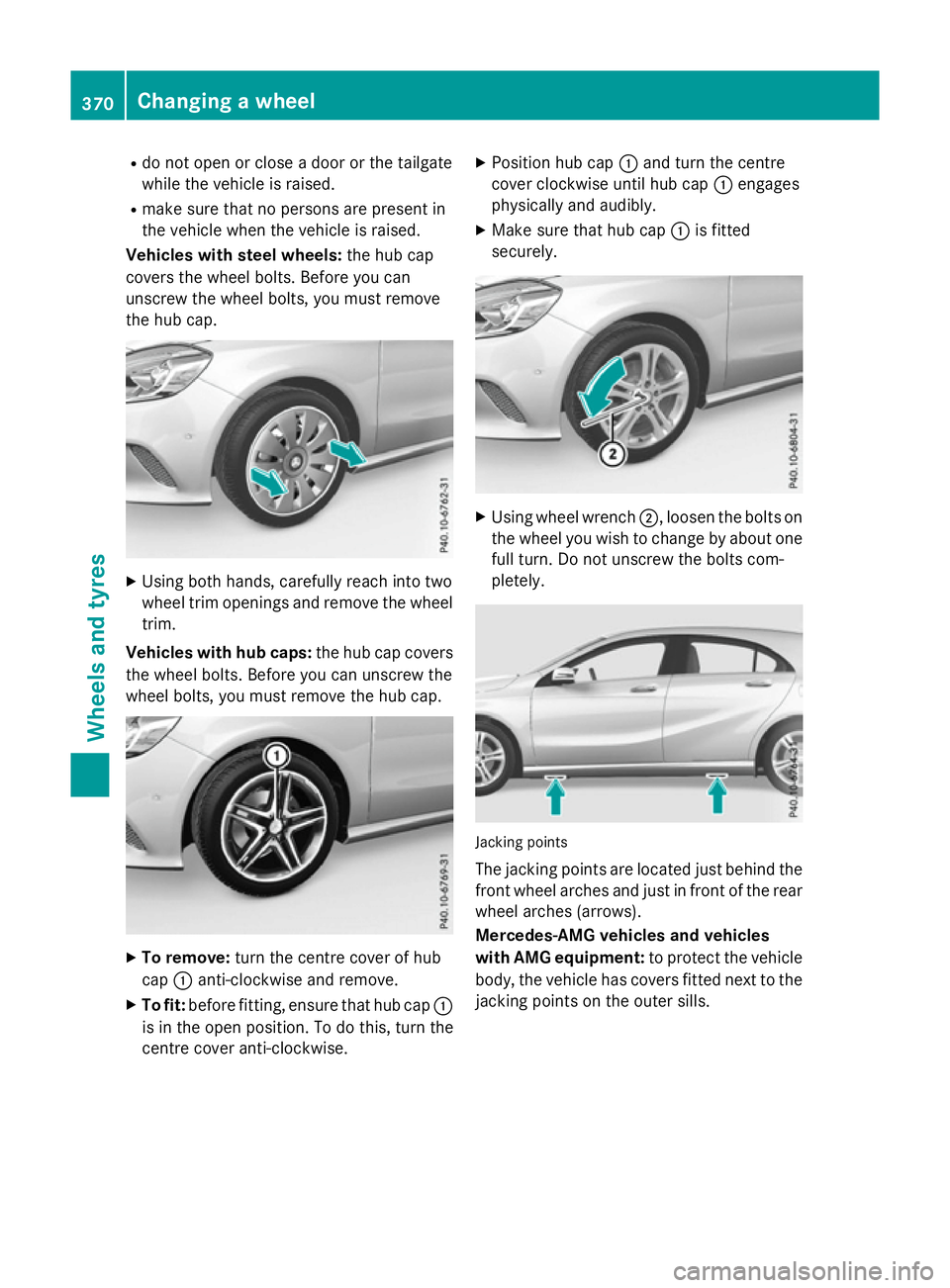
R
do not open or close a door or the tailgate
while the vehicle is raised.
R make sure that no persons are present in
the vehicle when the vehicle is raised.
Vehicles with steel wheels: the hub cap
covers the wheel bolts. Before you can
unscrew the wheel bolts, you must remove
the hub cap. X
Using both hands, carefully reach into two
wheel trim openings and remove the wheel trim.
Vehicles with hub caps: the hub cap covers
the wheel bolts. Before you can unscrew the
wheel bolts, you must remove the hub cap. X
To remove: turn the centre cover of hub
cap :anti-clockwise and remove.
X To fit: before fitting, ensure that hub cap :
is in the open position. To do this, turn the
centre cover anti-clockwise. X
Position hub cap :and turn the centre
cover clockwise until hub cap :engages
physically and audibly.
X Make sure that hub cap :is fitted
securely. X
Using wheel wrench ;, loosen the bolts on
the wheel you wish to change by about one full turn. Do not unscrew the bolts com-
pletely. Jacking points
The jacking points are located just behind the front wheel arches and just in front of the rear
wheel arches (arrows).
Mercedes-AMG vehicles and vehicles
with AMG equipment: to protect the vehicle
body, the vehicle has covers fitted next to the jacking points on the outer sills. 370
Changing a wheelWheels and tyres
Page 374 of 417
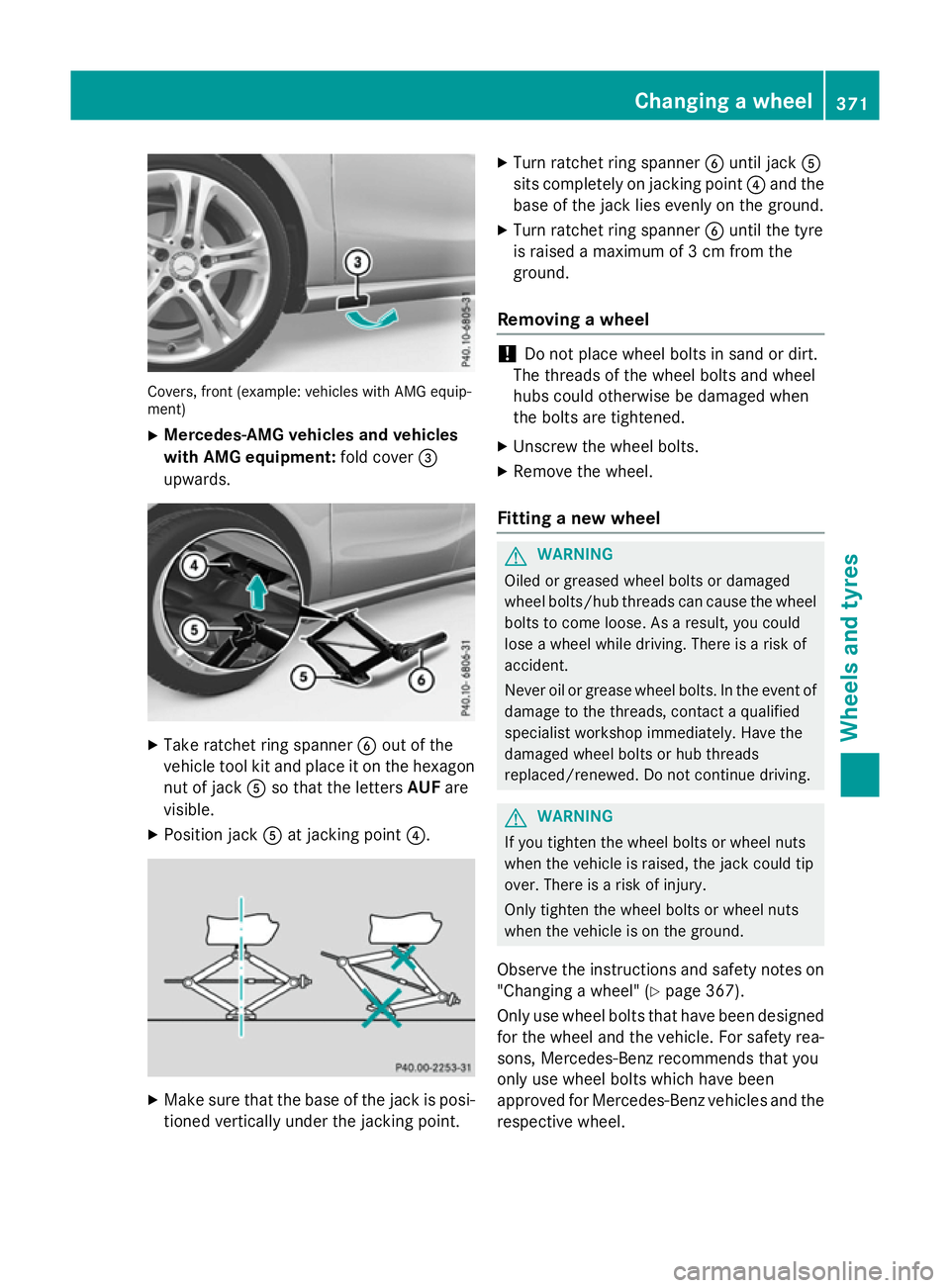
Covers, front (example: vehicles with AMG equip-
ment)
X Mercedes-AMG vehicles and vehicles
with AMG equipment: fold cover=
upwards. X
Take ratchet ring spanner Bout of the
vehicle tool kit and place it on the hexagon nut of jack Aso that the letters AUFare
visible.
X Position jack Aat jacking point ?. X
Make sure that the base of the jack is posi-
tioned vertically under the jacking point. X
Turn ratchet ring spanner Buntil jack A
sits completely on jacking point ?and the
base of the jack lies evenly on the ground.
X Turn ratchet ring spanner Buntil the tyre
is raised a maximum of 3 cm from the
ground.
Removing a wheel !
Do not place wheel bolts in sand or dirt.
The threads of the wheel bolts and wheel
hubs could otherwise be damaged when
the bolts are tightened.
X Unscrew the wheel bolts.
X Remove the wheel.
Fitting a new wheel G
WARNING
Oiled or greased wheel bolts or damaged
wheel bolts/hub threads can cause the wheel bolts to come loose. As a result, you could
lose a wheel while driving. There is a risk of
accident.
Never oil or grease wheel bolts. In the event of damage to the threads, contact a qualified
specialist workshop immediately. Have the
damaged wheel bolts or hub threads
replaced/renewed. Do not continue driving. G
WARNING
If you tighten the wheel bolts or wheel nuts
when the vehicle is raised, the jack could tip
over. There is a risk of injury.
Only tighten the wheel bolts or wheel nuts
when the vehicle is on the ground.
Observe the instructions and safety notes on "Changing a wheel" (Y page 367).
Only use wheel bolts that have been designed
for the wheel and the vehicle. For safety rea-
sons, Mercedes-Benz recommends that you
only use wheel bolts which have been
approved for Mercedes-Benz vehicles and the
respective wheel. Changing a wheel
371Wheels and tyres Z
Page 375 of 417
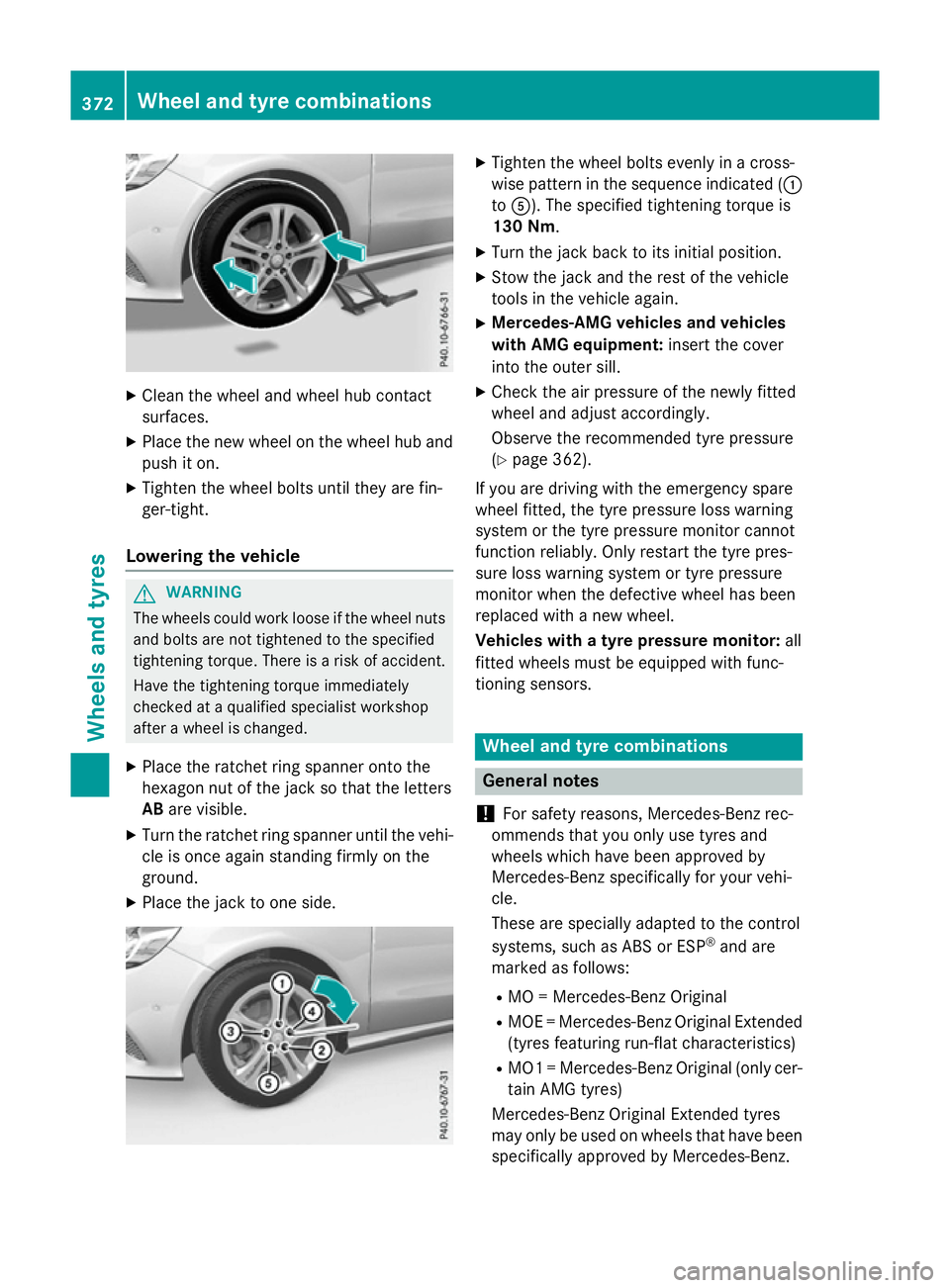
X
Clean the wheel and wheel hub contact
surfaces.
X Place the new wheel on the wheel hub and
push it on.
X Tighten the wheel bolts until they are fin-
ger-tight.
Lowering the vehicle G
WARNING
The wheels could work loose if the wheel nuts and bolts are not tightened to the specified
tightening torque. There is a risk of accident.
Have the tightening torque immediately
checked at a qualified specialist workshop
after a wheel is changed.
X Place the ratchet ring spanner onto the
hexagon nut of the jack so that the letters
AB are visible.
X Turn the ratchet ring spanner until the vehi-
cle is once again standing firmly on the
ground.
X Place the jack to one side. X
Tighten the wheel bolts evenly in a cross-
wise pattern in the sequence indicated ( :
to A). The specified tightening torque is
130 Nm .
X Turn the jack back to its initial position.
X Stow the jack and the rest of the vehicle
tools in the vehicle again.
X Mercedes-AMG vehicles and vehicles
with AMG equipment: insert the cover
into the outer sill.
X Check the air pressure of the newly fitted
wheel and adjust accordingly.
Observe the recommended tyre pressure
(Y page 362).
If you are driving with the emergency spare
wheel fitted, the tyre pressure loss warning
system or the tyre pressure monitor cannot
function reliably. Only restart the tyre pres-
sure loss warning system or tyre pressure
monitor when the defective wheel has been
replaced with a new wheel.
Vehicles with a tyre pressure monitor: all
fitted wheels must be equipped with func-
tioning sensors. Wheel and tyre combinations
General notes
! For safety reasons, Mercedes-Benz rec-
ommends that you only use tyres and
wheels which have been approved by
Mercedes-Benz specifically for your vehi-
cle.
These are specially adapted to the control
systems, such as ABS or ESP ®
and are
marked as follows:
R MO = Mercedes-Benz Original
R MOE = Mercedes-Benz Original Extended
(tyres featuring run-flat characteristics)
R MO1 = Mercedes-Benz Original (only cer-
tain AMG tyres)
Mercedes-Benz Original Extended tyres
may only be used on wheels that have been
specifically approved by Mercedes-Benz. 372
Wheel and tyre combinationsWheels and ty
res
Page 376 of 417
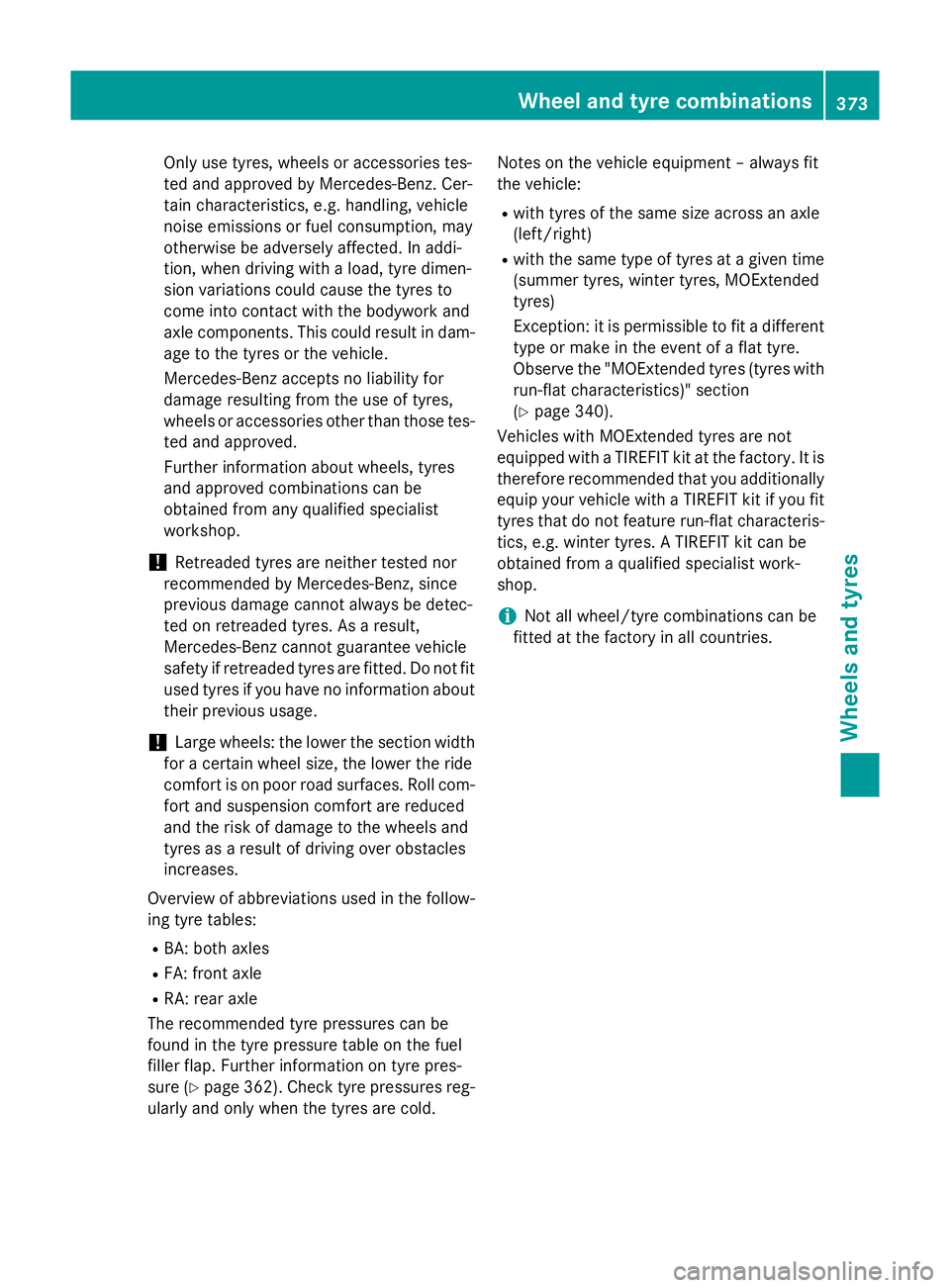
Only use tyres, wheels or accessories tes-
ted and approved by Mercedes-Benz. Cer-
tain characteristics, e.g. handling, vehicle
noise emissions or fuel consumption, may
otherwise be adversely affected. In addi-
tion, when driving with a load, tyre dimen-
sion variations could cause the tyres to
come into contact with the bodywork and
axle components. This could result in dam- age to the tyres or the vehicle.
Mercedes-Benz accepts no liability for
damage resulting from the use of tyres,
wheels or accessories other than those tes-
ted and approved.
Further information about wheels, tyres
and approved combinations can be
obtained from any qualified specialist
workshop.
! Retreaded tyres are neither tested nor
recommended by Mercedes-Benz, since
previous damage cannot always be detec-
ted on retreaded tyres. As a result,
Mercedes-Benz cannot guarantee vehicle
safety if retreaded tyres are fitted. Do not fit
used tyres if you have no information about their previous usage.
! Large wheels: the lower the section width
for a certain wheel size, the lower the ride
comfort is on poor road surfaces. Roll com-
fort and suspension comfort are reduced
and the risk of damage to the wheels and
tyres as a result of driving over obstacles
increases.
Overview of abbreviations used in the follow- ing tyre tables:
R BA: both axles
R FA: front axle
R RA: rear axle
The recommended tyre pressures can be
found in the tyre pressure table on the fuel
filler flap. Further information on tyre pres-
sure (Y page 362). Check tyre pressures reg-
ularly and only when the tyres are cold. Notes on the vehicle equipment – always fit
the vehicle:
R with tyres of the same size across an axle
(left/right)
R with the same type of tyres at a given time
(summer tyres, winter tyres, MOExtended
tyres)
Exception: it is permissible to fit a different
type or make in the event of a flat tyre.
Observe the "MOExtended tyres (tyres with
run-flat characteristics)" section
(Y page 340).
Vehicles with MOExtended tyres are not
equipped with a TIREFIT kit at the factory. It is
therefore recommended that you additionally equip your vehicle with a TIREFIT kit if you fit tyres that do not feature run-flat characteris-
tics, e.g. winter tyres. A TIREFIT kit can be
obtained from a qualified specialist work-
shop.
i Not all wheel/tyre combinations can be
fitted at the factory in all countries. Wheel and tyre combinations
373Wheels and tyres Z
Page 377 of 417
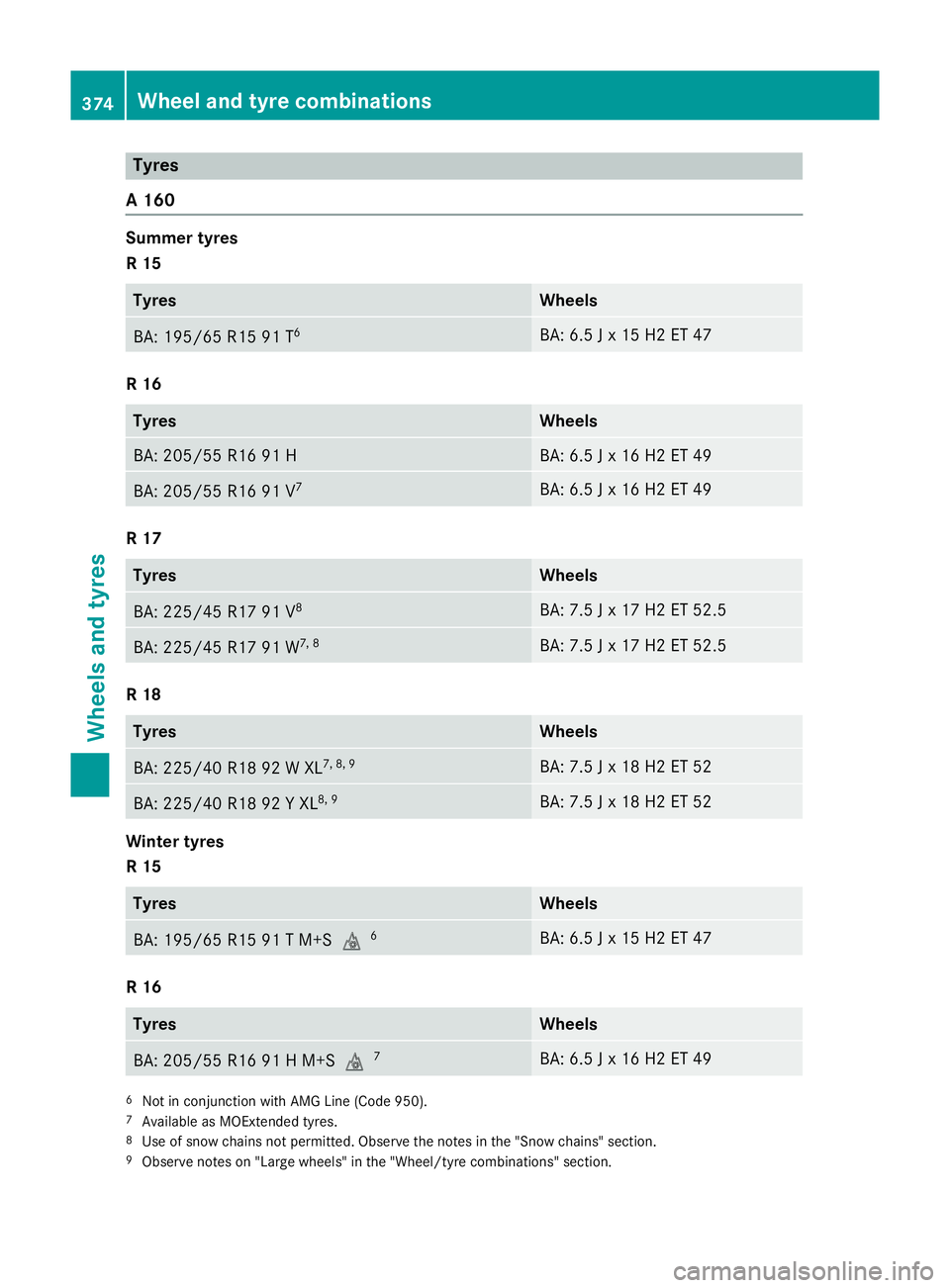
Tyres
A 160 Summer tyres
R 15
Tyres Wheels
BA: 195/6
5 R15 91 T 6 BA: 6.5 J x 15 H2 ET 47
R 16
Tyres Wheels
BA: 205/55 R16 91 H BA: 6.5 J x 16 H2 ET 49
BA: 205/55 R16 91 V
7 BA: 6.5 J x 16 H2 ET 49
R 17
Tyres Wheels
BA: 225/45 R17 91 V
8 BA: 7.5 J x 17 H2 ET 52.5
BA: 225/45 R17 91 W
7, 8 BA: 7.5 J x 17 H2 ET 52.5
R 18
Tyres Wheels
BA: 225/40 R18 92 W XL
7, 8, 9 BA: 7.5 J x 18 H2 ET 52
BA: 225/40 R18 92 Y XL
8, 9 BA: 7.5 J x 18 H2 ET 52
Winter tyres
R 15
Tyres Wheels
BA: 195/65 R15 91 T M+Si
6 BA: 6.5 J x 15 H2 ET 47
R 16
Tyres Wheels
BA: 205/55 R16 91 H M+S
i7 BA: 6.5 J x 16 H2 ET 49
6
Not in conjunction with AMG Line (Code 950).
7 Available as MOExtended tyres.
8 Use of snow chains not permitted. Observe the notes in the "Snow chains" section.
9 Observe notes on "Large wheels" in the "Wheel/tyre combinations" section. 374
Wheel and tyre combinationsWheels and tyres
Page 378 of 417
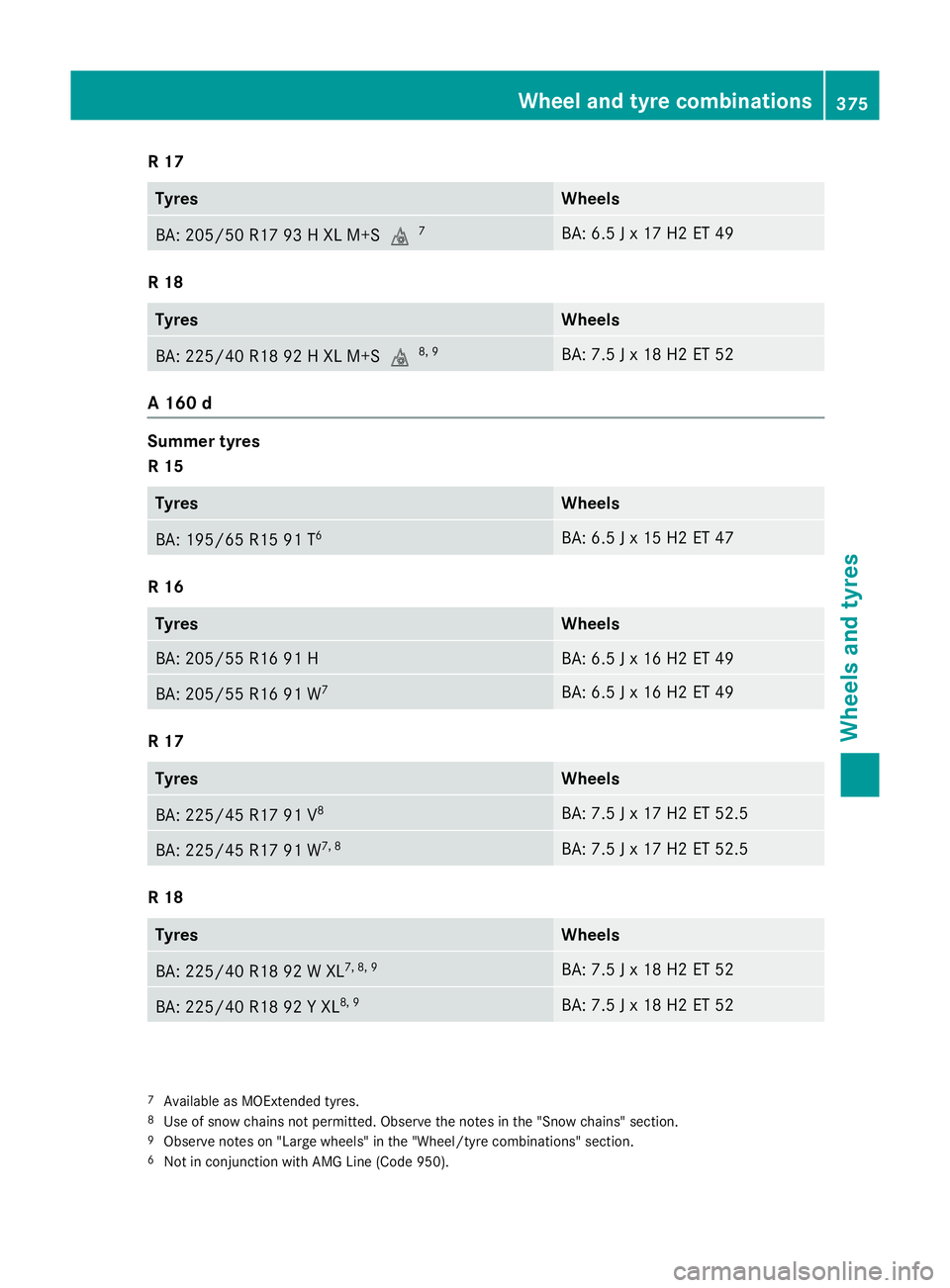
R 17
Tyres Wheels
BA: 205/50 R17 93 H XL M+S
i7 BA: 6.5 J x 17 H2 ET 49
R 18
Tyres Wheels
BA: 225/40 R18 92 H XL M+S
i8, 9 BA: 7.5 J x 18 H2 ET 52
A 160 d
Summer tyres
R 15
Tyres Wheels
BA: 195/65 R15 91 T
6 BA: 6.5 J x 15 H2 ET 47
R 16
Tyres Wheels
BA: 205/55 R16 91 H BA: 6.5 J x 16 H2 ET 49
BA: 205/55 R16 91 W
7 BA: 6.5 J x 16 H2 ET 49
R 17
Tyres Wheels
BA: 225/45 R17 91 V
8 BA: 7.5 J x 17 H2 ET 52.5
BA: 225/45 R17 91 W
7, 8 BA: 7.5 J x 17 H2 ET 52.5
R 18
Tyres Wheels
BA: 225/40 R18 92 W XL
7, 8, 9 BA: 7.5 J x 18 H2 ET 52
BA: 225/40 R18 92 Y XL
8, 9 BA: 7.5 J x 18 H2 ET 52
7
Available as MOExtended tyres.
8 Use of snow chains not permitted. Observe the notes in the "Snow chains" section.
9 Observe notes on "Large wheels" in the "Wheel/tyre combinations" section.
6 Not in conjunction with AMG Line (Code 950). Wheel and tyre combinations
375Wheels and tyres Z
Page 379 of 417
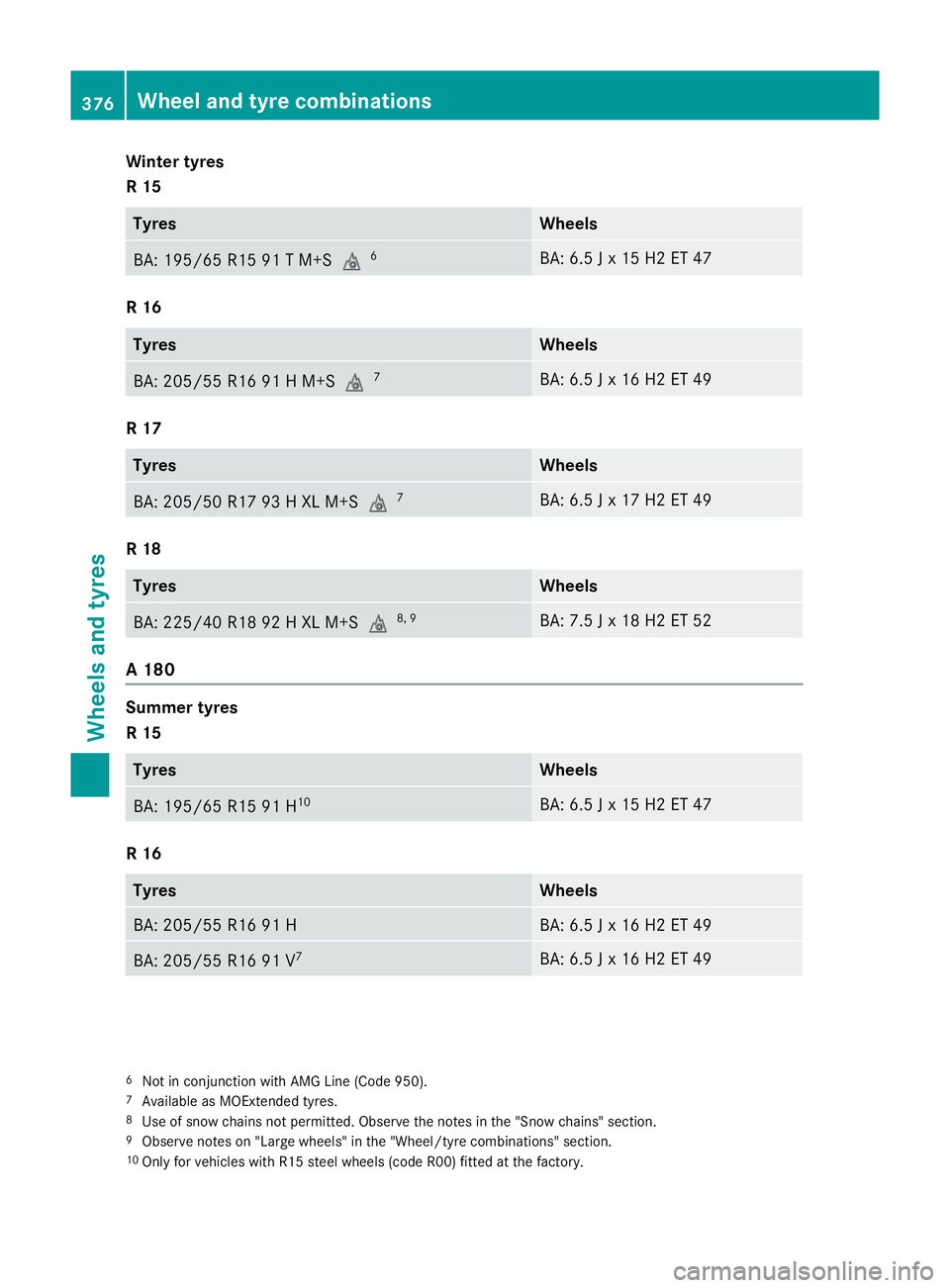
Winter tyres
R 15
Tyres Wheels
BA: 195/65 R15 91 T M+Si
6 BA: 6.5 J x 15 H2 ET 47
R 16
Tyres Wheels
BA: 205/55 R16 91 H M+Si
7 BA: 6.5 J x 16 H2 ET 49
R 17
Tyres Wheels
BA: 205/50 R17 93 H XL M+Si
7 BA: 6.5 J x 17 H2 ET 49
R 18
Tyres Wheels
BA: 225/40 R18 92 H XL M+Si
8, 9 BA: 7.5 J x 18 H2 ET 52
A 180
Summer tyres
R 15
Tyres Wheels
BA: 195/65 R15 91 H
10 BA: 6.5 J x 15 H2 ET 47
R 16
Tyres Wheels
BA: 205/55 R16 91 H BA: 6.5 J x 16 H2 ET 49
BA: 205/55 R16 91 V
7 BA: 6.5 J x 16 H2 ET 49
6
Not in conjunction with AMG Line (Code 950).
7 Available as MOExtended tyres.
8 Use of snow chains not permitted. Observe the notes in the "Snow chains" section.
9 Observe notes on "Large wheels" in the "Wheel/tyre combinations" section.
10 Only for vehicles with R15 steel wheels (code R00) fitted at the factory. 376
Wheel and tyre combinationsWheels and tyres
Page 380 of 417
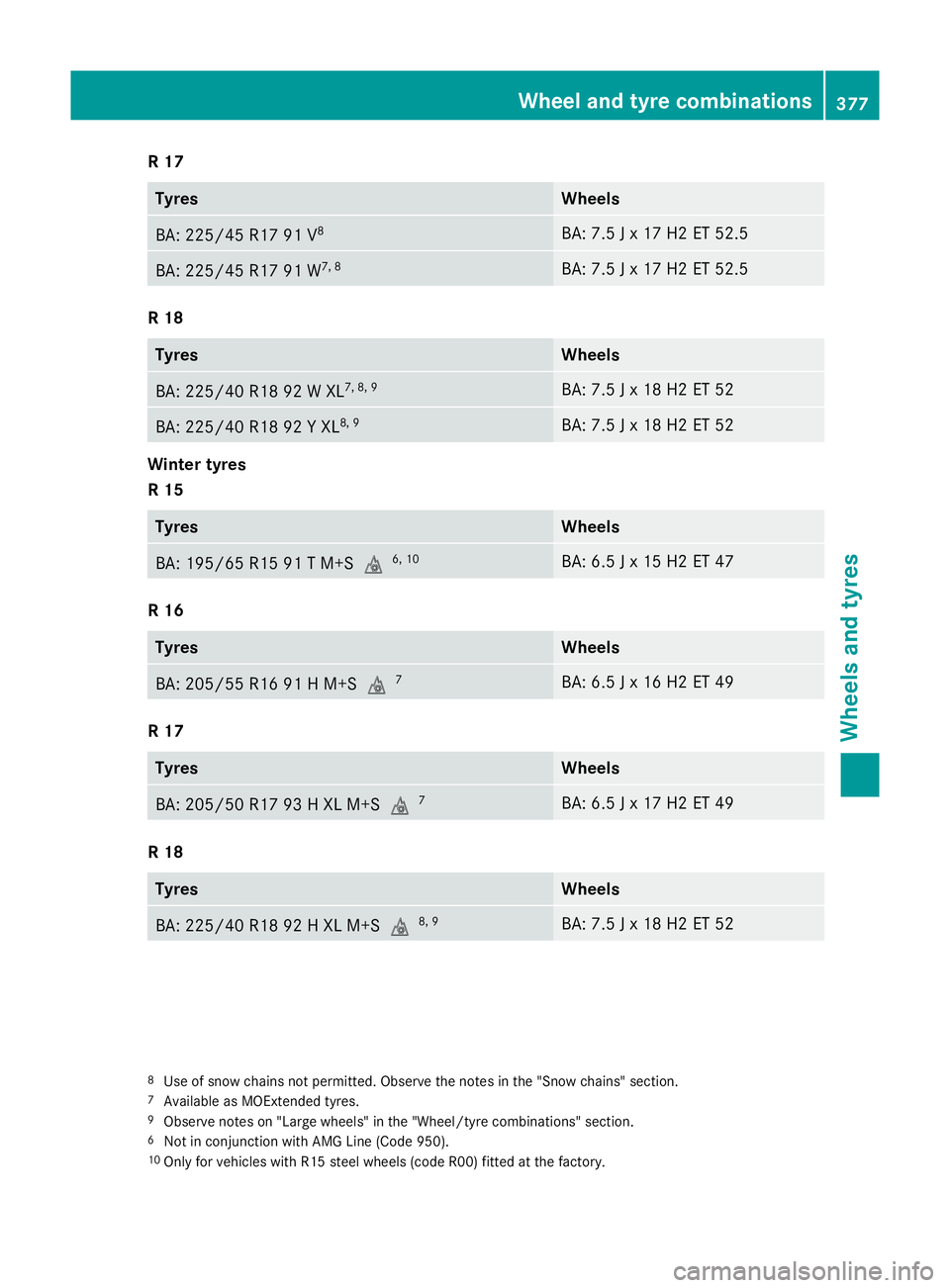
R 17
Tyres Wheels
BA: 225/45 R17 91 V
8 BA: 7.5 J x 17 H2 ET 52.5
BA: 225/45 R17 91 W
7, 8 BA: 7.5 J x 17 H2 ET 52.5
R 18
Tyres Wheels
BA: 225/40 R18 92 W XL
7, 8, 9 BA: 7.5 J x 18 H2 ET 52
BA: 225/40 R18 92 Y XL
8, 9 BA: 7.5 J x 18 H2 ET 52
Winter tyres
R 15
Tyres Wheels
BA: 195/65 R15 91 T M+Si
6, 10 BA: 6.5 J x 15 H2 ET 47
R 16
Tyres Wheels
BA: 205/55 R16 91 H M+S
i7 BA: 6.5 J x 16 H2 ET 49
R 17
Tyres Wheels
BA: 205/50 R17 93 H XL M+S
i7 BA: 6.5 J x 17 H2 ET 49
R 18
Tyres Wheels
BA: 225/40 R18 92 H XL M+S
i8, 9 BA: 7.5 J x 18 H2 ET 52
8
Use of snow chains not permitted. Observe the notes in the "Snow chains" section.
7 Available as MOExtended tyres.
9 Observe notes on "Large wheels" in the "Wheel/tyre combinations" section.
6 Not in conjunction with AMG Line (Code 950).
10 Only for vehicles with R15 steel wheels (code R00) fitted at the factory. Wheel and tyre combinations
377Wheels and tyres Z